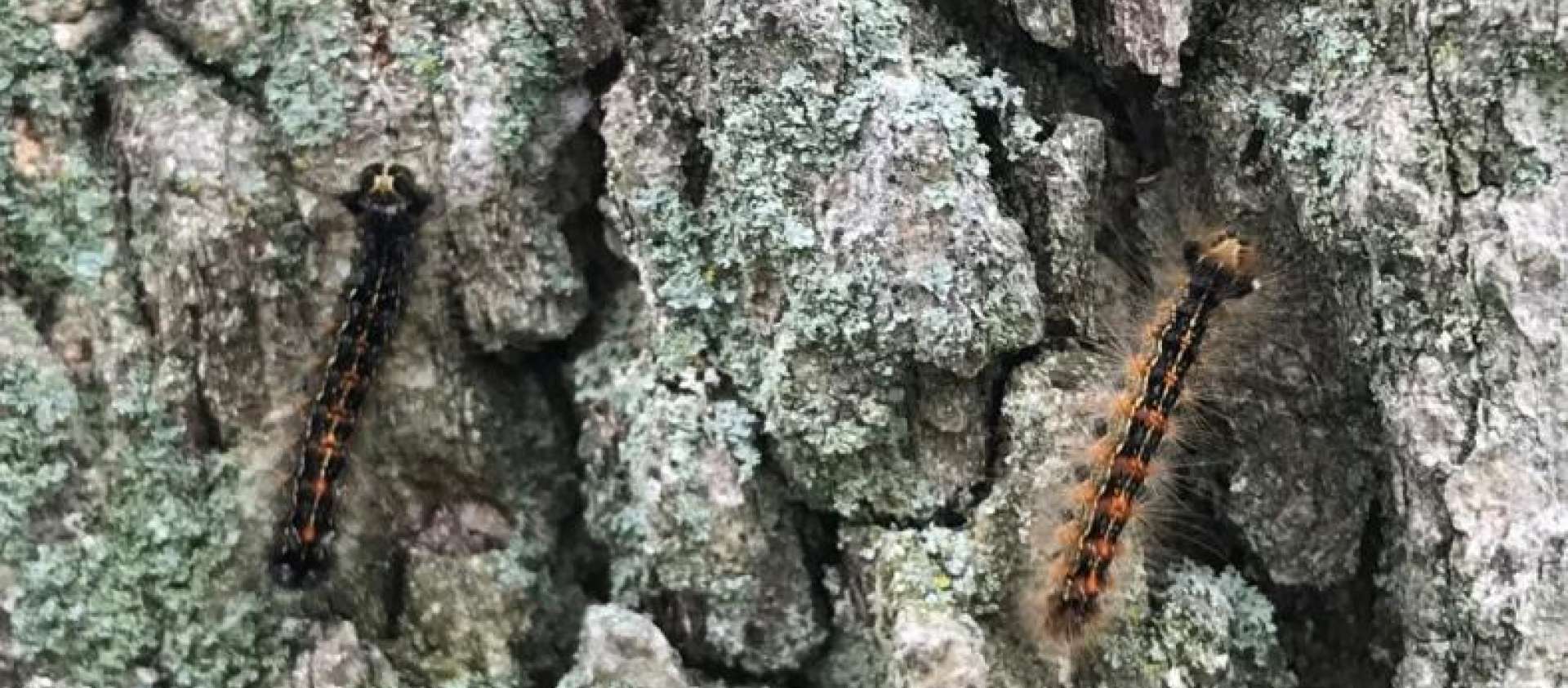
European Gypsy Moth Information Update
European Gypsy Moth (Lymantria dispar)
The Gypsy Moth is a non-native insect from Europe that was introduced to North America in the 1860s. The insect has become naturalized to Eastern North America, including Middlesex County. It has spread widely in areas where Oak is found, its preferred host tree species, in both rural and urban ecosystems. The gypsy moth feeds on more than 300 species of trees and shrubs including: Aspen, Birch, Cedar, Cottonwood, Fruit trees, Larch, Oak (preferred host), Poplar, and Willow.
This insects’ population dynamics can be described as boom and bust, where every 8-12 years, the population within certain areas will reach epidemic proportions only to collapse again and remain at endemic levels for another eight years or so. Gypsy moth outbreaks may appear suddenly and may continue for two to five years in a location. During a population outbreak, the caterpillars in very large numbers can be observed feeding within trees, defecating, and dangling from silk threads.
The Gypsy Moth spreads as egg masses are inadvertently moved on firewood, cars, trucks, trailers, RV's, boats, ATV, etc. If the relocated eggs hatch in their new location and they find host trees a new population will occur. It is important to inspect all items that are moved to and from locations that may have the Gypsy Moth.
- Identification
Newly hatched caterpillars are about half a centimetre long and dark in colour. European Gypsy Moth caterpillars grow and change in appearance over the span of one to two months. As they grow, they moult or shed their skin. By the fourth moult, the pairs of characteristic blue and red dots are visible on their back and they are about six to seven centimetres in length.
- Tree Damage
When the insect population dynamics are at their peak, Gypsy Moth caterpillars can defoliate its host tree canopy severely and sometimes even completely. Within a rural forest setting most healthy trees will replace the leaf loss experienced in spring defoliation events later in the year with new leaf canopy in order to perpetuate annual growth and development. Natural rural forests growing in relatively undisturbed woodlands also tend to consist of increased species diversity and support greater numbers of predators, thereby possessing more resilience to disturbance events.
In contrast to trees within a rural setting, trees in urban settings are typically exposed to additional environmental stressors such as drought, altered hydrology, compacted soils, fragmentation, pesticides, air pollutants, and fewer natural predators. These additional stresses can expose urban forests, parkland trees, boulevard trees, and private yard trees to an increased level of damage as they may have limited resources to draw from during the recovery phase following defoliation.
- Natural Controls
Despite the introduction of this insect in North America, it has three significant natural enemies:
1. a fungus (Entomophaga maimaiga)
2. a virus (Nucelopolyhedrosis)
3. a small wasp (Encyrtidae family)
The fungus and virus can be very effective at naturally controlling populations; however, they require a cool wet spring to be effective. The wasp can parasitize up to 30% of the eggs that are near the surface of an egg mass, but cannot reach the eggs in the center of the mass. Birds, bats, and several mammals also predate the species at various stages of their life cycle.
- Landowner Control Measures
Natural population control factors most often combine to cause a collapse of Gypsy Moth outbreaks. However, consecutive years of the Gypsy Moth outbreak can cause defoliation which can lead to tree mortality and intervention may be considered. Common Landowner control measures include egg mass removal, picking caterpillars, and insecticide application using a third-party professional. Landowners may wish to consult with a local tree care company to seek advice and services in controlling this pest on their land.
Egg mass removal – Late Fall / Winter
Egg mass scraping in the fall and winter can significantly reduce the population in the following years. Putting the egg masses in soapy water overnight will kill the eggs.
Egg mass scraping instructions
Hand picking caterpillars – May / June
As caterpillars emerge and climb trees to eat the foliage, they can be hand-picked or shaken out of small trees and destroyed by placing them in a bucket of soapy water overnight. Birds will also help with this activity, therefore encouraging birds to nest in your landscapes can help dramatically reduce numbers.
Burlap wraps and sticky bands – May to August
Placing burlap wraps and sticky banding around the stems of trees can help capture and destroy large numbers of caterpillars, as well as the adult female moths when they emerge to lay their eggs.
Pheromone Traps/Lures
The female adult moth does not fly; therefore, they cannot be trapped, but the male adult moths can be trapped with the use of female sex pheromone traps. Although the traps are commercially advertised as a control method, traps are more relevant to monitoring for the presence of the insect.
Professional Help (Insecticides)
If other control measures have failed to keep numbers to a manageable level, a landowner may choose to have this pest controlled using an insecticidal spray. Local tree care companies can help with this using ground-based spraying or aerial bucket truck equipment and certified applicators.
